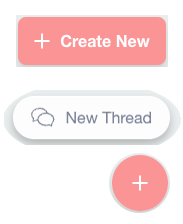We’d like to remind Forumites to please avoid political debate on the Forum.
This is to keep it a safe and useful space for MoneySaving discussions. Threads that are – or become – political in nature may be removed in line with the Forum’s rules. Thank you for your understanding.
📨 Have you signed up to the Forum's new Email Digest yet? Get a selection of trending threads sent straight to your inbox daily, weekly or monthly!
RFID tags for home library

Gers
Posts: 13,458 Forumite






in Techie Stuff
An idle thought / query.
One of my friends has an extensive home library which will need catalogued soon.
Is it possible to buy RFID tags for home use? Is it practical to use them on books?
He's an architect, has hundreds and hundreds of books, mostly non-fiction. They are all on one huge wall on floor to ceiling shelves. As he's just moved house there is only a fairly loose 'order' to the books for the moment so it would make sense to do the tags as they are being re-arranged.
Is it a daft idea? If so, is there a better one?
Thanks
One of my friends has an extensive home library which will need catalogued soon.
Is it possible to buy RFID tags for home use? Is it practical to use them on books?
He's an architect, has hundreds and hundreds of books, mostly non-fiction. They are all on one huge wall on floor to ceiling shelves. As he's just moved house there is only a fairly loose 'order' to the books for the moment so it would make sense to do the tags as they are being re-arranged.
Is it a daft idea? If so, is there a better one?
Thanks
0
Comments
-
The short answer to your question is bar codes. also far cheaper and easier.An idle thought / query.
One of my friends has an extensive home library which will need catalogued soon.
Is it possible to buy RFID tags for home use? Is it practical to use them on books?
He's an architect, has hundreds and hundreds of books, mostly non-fiction. They are all on one huge wall on floor to ceiling shelves. As he's just moved house there is only a fairly loose 'order' to the books for the moment so it would make sense to do the tags as they are being re-arranged.
Is it a daft idea? If so, is there a better one?
Thanks
the long answer it that it could be possible but expensive. RFID for shop security is cheaper, and some of them are a tuned circuit just absorb energy to trigger an alarm. However for each proper RFID device like oyster cards have their own unique id is more expensive. Also one you trigger the RFID it send a signal back, but if two items send two signals back at the same time will corrupt both signals from being received. to get around this is why the card must be swiped in close proximity, and also only one card at a time.
While the RFID can transmit more than just a single number, complexity adds cost.
What ever it transmits, or even if you barcode scan it, always generates at least a number, and you have to associate that number with a meaning, usually into a database of some type, but the database has to be populated with data that someone has to input0 -
Most public libraries use RFID as technology for self service, that's where the real advantage is to them so people can take and return books automatically.
He might do better just to rearrange them by the Dewey codes, you can scan a book by its ISBN number to see what public libraries classify them as and just use that:
http://classify.oclc.org/classify2/0 -
+1 bar codes. He can print them off with readily available software by an inkjet printer on adhesive label A4 sheets, and catalogue them on a laptop or PC. Could also scan them with a mobile phone. Bar codes are good for asset management because they’re cheap. RFID tags and associated readers (fixed or portable) are relatively expensive and suited to automated volume transaction points such as public libraries, busses, access points, etc.
I can’t imagine your friend regularly checking his books in and out.0 -
Thanks for the advice in response to my query. I'll pass it all on.
Bar codes sound the way to go. I've found an Avery template for making appropriate labels. I'll let him work out how to do 'stuff'.
Cheers.0 -
+1 for barcodes. I use an app on my phone to catalog all my book. It's called book crawler. It can read the barcode of a book and uses the Internet to find the author and title.The comments I post are my personal opinion. While I try to check everything is correct before posting, I can and do make mistakes, so always try to check official information sources before relying on my posts.0
-
+1 for barcodes. I use an app on my phone to catalog all my book. It's called book crawler. It can read the barcode of a book and uses the Internet to find the author and title.
Doesn't the book itself tell you the author and title?
I think I must be having a senior moment... What purpose does cataloguing the books serve?
What purpose does cataloguing the books serve?
Couldn't you just write a 3 (or 4) digit serial number on the spine rather than using barcodes or RFID tags...?0 -
If he goes for barcodes, it's easy to get bulk sheets/rolls of barcodes already printed to order. They're usually laminated so more hardwearing than anything home printed, eg
https://www.abbeylabels.co.uk/barcode-labels.html
https://www.gresswell.co.uk/colour-coded-barcode-labels.html
If you do want individual RFID, £300 per 1500 tags
https://www.gresswell.co.uk/3mtm-rfid-tags.html
Obviously you also need scanners, software etc as well.
Libraries use individual barcodes or RFID tags because they have to identify individual copies of books. Most private libraries will only have one copy of each, and won't do much lending, and so for anything after 1970 the ISO standard ISBN barcode or EAN13 barcode on the cover will probably be adequate, and most items won't need individual tagging.
More important is the classmark which is usually marked on the spine and refers to how the library is organised for shelving. Dewey is used in most public libraries.A kind word lasts a minute, a skelped erse is sair for a day.0 -
+1 for barcodes. I use an app on my phone to catalog all my book. It's called book crawler. It can read the barcode of a book and uses the Internet to find the author and title.
This does bring to mind a mental picture of you retrieving a book from a shelf, then searching the house for your phone in order to scan the barcode to determine who wrote the book and what its called, then downloading and opening the Kindle version on said phone 0
0 -
Thanks all.
I think my friend wants to not only catalogue his fairly extensive book collection but also to find out where each one is more easily, especially as the shelving is floor to almost ceiling in a double height room.
I shall pass on all suggestions. :T0 -
QR codes?
Same concept as barcodes, but with the possibility of holding more info on the actual label.
In my experience of cataloging electronic components, I went with a simple catalog number, printed on standard format labels. I couldn't get barcoding to work in any way that wasn't more effort than simply referring to the item by its name and/or catalog number.0
This discussion has been closed.
Confirm your email address to Create Threads and Reply

Categories
- All Categories
- 352.9K Banking & Borrowing
- 253.9K Reduce Debt & Boost Income
- 454.7K Spending & Discounts
- 246K Work, Benefits & Business
- 602K Mortgages, Homes & Bills
- 177.8K Life & Family
- 259.9K Travel & Transport
- 1.5M Hobbies & Leisure
- 16K Discuss & Feedback
- 37.7K Read-Only Boards




